
Justicia brandegeeana, the Mexican shrimp plant, shrimp plant or false hop, is an evergreen shrub in the genus Justicia of the acanthus family Acanthaceae, native to Mexico, and also naturalized in Florida.

Fuchsia is a genus of flowering plants that consists mostly of shrubs or small trees. The first to be scientifically described, Fuchsia triphylla, was discovered on the Caribbean island of Hispaniola about 1696–1697 by the French Minim monk and botanist, Charles Plumier, during his third expedition to the Greater Antilles. He named the new genus after German botanist Leonhart Fuchs (1501–1566).

Alstroemeria, commonly called the Peruvian lily or lily of the Incas, is a genus of flowering plants in the family Alstroemeriaceae. They are all native to South America although some have become naturalized in the United States, Mexico, Australia, New Zealand, Madeira and the Canary Islands. Almost all of the species are restricted to one of two distinct centers of diversity, one in central Chile, the other in eastern Brazil. Species of Alstroemeria from Chile are winter-growing plants while those of Brazil are summer-growing. All are long-lived perennials except A. graminea, a diminutive annual from the Atacama Desert of Chile.

Pieris is a genus of seven species of shrubs in the flowering plant family Ericaceae, native to mountain regions of eastern and southern Asia, eastern North America and Cuba. Known commonly in North America as andromedas or fetterbushes, they are broad-leaved evergreen shrubs growing to 1–6 metres tall and 3–10 ft (0.9–3.0 m) wide. The leaves are spirally arranged, often appearing to be in whorls at the end of each shoot with bare stretches of shoot below; they are lanceolate-ovate, 2–10 cm (0.8–3.9 in) long and 1.0–3.5 cm (0.4–1.4 in) broad, leathery textured, and with an entire or serrated margin. The young leaves in spring are typically brightly coloured. The flowers are bell-shaped, 5–15 mm (0.2–0.6 in) long, white or pink, and arranged in racemes 5–12 cm (2.0–4.7 in) long. The fruit is a woody capsule which splits into five sections to release the numerous small seeds.

Justicia is a genus of flowering plants in the family Acanthaceae. It is the largest genus within the family, encompassing around 700 species with hundreds more as yet unresolved. They are native to tropical to warm temperate regions of the Americas, India and Africa. The genus serves as host to many butterfly species, such as Anartia fatima. Common names include water-willow and shrimp plant, the latter from the inflorescences, which resemble a shrimp in some species. The generic name honours Scottish horticulturist James Justice (1698–1763). They are closely related to Pachystachys.

Wisteria floribunda, common name Japanese wisteria, is a species of flowering plant in the family Fabaceae, native to Japan. Growing to 9 m (30 ft), it is a woody, deciduous twining climber. It was first brought from Japan to the United States in the 1830s. Since then, it has become one of the most highly romanticized flowering garden plants. It is also a common subject for bonsai, along with Wisteria sinensis.

Wisteria sinensis, commonly known as the Chinese wisteria, is a species of flowering plant in the pea family, native to China, in the provinces of Guangxi, Guizhou, Hebei, Henan, Hubei, Shaanxi, and Yunnan. Growing 20–30 m (66–98 ft) tall, it is a deciduous vine. It is widely cultivated in temperate regions for its twisting stems and masses of scented flowers in hanging racemes, in spring.

Weigela is a genus of between six and 38 species of deciduous shrubs in the family Caprifoliaceae, growing to 1–5 m (3–15′) tall. All are natives of eastern Asia. The genus is named after the German scientist Christian Ehrenfried Weigel.

Lamprocapnos spectabilis, bleeding heart, fallopian buds or Asian bleeding-heart, is a species of flowering plant in the poppy family Papaveraceae, native to Siberia, northern China, Korea and Japan. It is the sole species in the monotypic genus Lamprocapnos, but is still widely referenced under its old name Dicentra spectabilis. It is valued in gardens and in floristry for its heart-shaped pink and white flowers, borne in spring.

Fuchsia magellanica, commonly known as the hummingbird fuchsia or hardy fuchsia, is a species of flowering plant in the evening primrose family Onagraceae, native to the lower Southern Cone of southern South America.
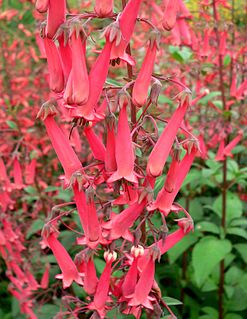
Phygelius capensis, the cape figwort or cape fuchsia, is a species of flowering plant in the family Scrophulariaceae, native to South Africa.

Malus floribunda, common name Japanese flowering crabapple, Japanese crab, purple chokeberry, or showy crabapple, originates from Japan and East Asia. It may be a hybrid of M. sieboldii with M. baccata, in which case it would be written as Malus × floribunda.
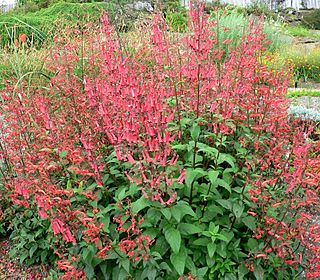
Phygelius, common names Cape fuchsia or Cape figwort, is a genus of flowering plants in the family Scrophulariaceae, native to wet slopes and banks in southern Africa. They are evergreen shrubs often treated as perennials in colder climates. They bear many pendent tubular flowers over a long period in summer, in shades of white, yellow and red. The vague similarity of the blooms to fuchsias has led to the common name Cape fuchsia, though they are not closely related.
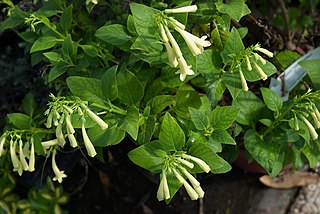
Phygelius aequalis is a species of flowering plant in the family Scrophulariaceae, native to South Africa. It is a semi-evergreen shrub growing to 1 m (3 ft) tall and wide, with 25 cm (10 in) long panicles of pink flowers with crimson lobes and yellow throats. This species may be distinguished from the closely related Phygelius capensis by the fact that the flowers grow in a single plane along one side of the stem. The narrowly tubular flowers are up to 6 cm (2 in) in length.

Stephanotis floribunda syn. S. jasminoides, the Madagascar jasmine, waxflower, Hawaiian wedding flower, or bridal wreath is a species of flowering plant in the family Apocynaceae, native to Madagascar. It is a twining, sparsely branched liana that can measure up to 6 m in length.

Ribes speciosum is a species of flowering plant in the family Grossulariaceae, which includes the edible currants and gooseberries. It is a spiny deciduous shrub with spring-flowering, elongate red flowers that resemble fuchsias, though it is not closely related. Its common names are fuchsia-flowered gooseberry and Californian fuchsia. It is native to central and southern California and Baja California, where it grows in the scrub and chaparral of the coastal mountain ranges.
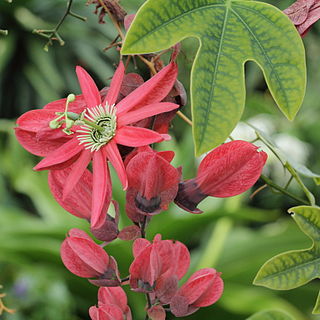
Passiflora racemosa, the red passion flower, is a species of flowering plant in the family Passifloraceae, native to Brazil. It is an evergreen climber growing to 5 m (16 ft), with simple or 3-lobed leaves to 10 cm (4 in) long, and vivid red flowers borne in summer. The flowers are 12 cm (5 in) in diameter, with purple and white coronas. They are followed by oblong green fruits.

Linnaea floribunda is a species of flowering plant in the honeysuckle family, Caprifoliaceae, native to Mexico. Growing to 4 m (13 ft) tall and broad, it is a semi-evergreen or evergreen shrub with shiny ovate leaves and clusters of tubular cerise flowers to 5 cm (2.0 in) long. Though hardy down to −10 °C (14 °F) it prefers a sheltered location, for instance against a south-facing stone wall.

Pieris floribunda is a North American species of broadleaf evergreen shrub, a member of the fetterbush genus in the blueberry family (Ericaceae). It is commonly known in North America as mountain fetterbush or mountain andromeda. All parts of Pieris floribunda are poisonous if ingested. In landscapes it should be grown in full to part shade, out of windy locations, and have a good quality soil with much organic matter with acidity of pH 4.5 to 6.5.
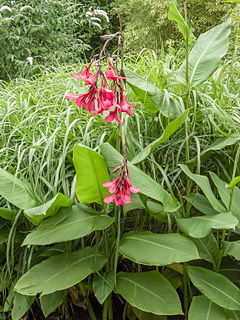
Canna × ehemannii is an early cultivar of canna, believed to be a hybrid between Canna indica and Canna iridiflora. Its name is sometimes spelt Canna × ehemanii, although it has the English name Ehemann's canna. It has gained the Royal Horticultural Society's Award of Garden Merit.





















